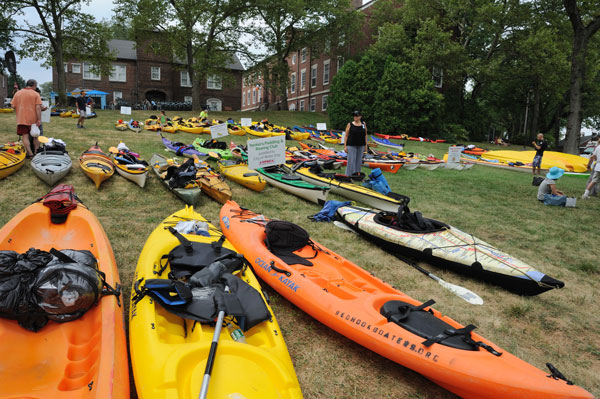
BY TERESE LOEB KREUZER | A flight over New York City shows its numerous islands set like gemstones and surrounded by gleaming bands of water. Rivers, estuaries, bays, wetlands and the Atlantic Ocean comprise 520 miles of the city’s shoreline, binding New York and New Jersey into one complicated ecosystem.
But, said Roland Lewis, president and chief executive officer of the Metropolitan Waterfront Alliance (M.W.A.), many New Yorkers just think of their home as the five boroughs. They don’t realize that there is a “sixth borough” — the water — and that they live in an archipelago.
The M.W.A.’s fifth annual City of Water Day, which took place this year on Sat., July 14, tried to drive this point home by offering scores of opportunities to get on the water and learn more about it.
Lewis estimated that more than 25,000 people showed up for this year’s City of Water Day, centered as usual on Governors Island and in Jersey City’s Liberty State Park. In addition, 15 local waterfront-related organizations staged neighborhood events.
Most people arrived on Governors Island via ferry. Some attendees kayaked from as far away as Yonkers in Westchester County.
Many of New York Harbor’s commercial boats offered free narrated tours that pointed out key landmarks and spoke to the ways in which the harbor affects the economy, the climate and the life of the metropolitan region.
About 6,000 people took a spin around the harbor, many of whom were on the water for the first time, according to Lewis. The exposure, he hopes, will help to address waterfront issues and spark a continued interest in using the water for recreation.
New York Harbor receives more commercial traffic than any other harbor on the East Coast. It is ranked as the third largest in the country, after Long Beach and Los Angeles, supporting 275,000 jobs.
But in order to retain that preeminence, the harbor has required dredging to a depth of 50 feet, and even that may not be deep enough to accommodate the super-sized vessels that will be carrying cargo once the newly widened Panama Canal opens in 2014. Initial dredging operations in the harbor should also be finished by that year.
“The challenge going forward will be maintenance,” Lewis said. “Mostly clean dredge material is now coming out of the harbor. Maintenance dredging will be dirtier. It will be sediment that washes down with the contaminants from upstream, so it’s more expensive to remove.”
Getting the funding to maintain these channels, he added, is a great challenge for the U.S. Army Corps of Engineers and the Port Authority of New York and New Jersey. The hope is that the federal government will provide the necessary money, but whether it will or not is uncertain.
This is only one of many pressing issues confronting the businesses that depend on the harbor and the organizations committed to its restoration for commercial, recreational and educational use.
“The East River ferry service celebrated its millionth passenger today,” Lewis said, “but the relatively nominal funding that makes that service possible is only in place for three years.”
Ridership on the East River Ferry has been twice as large as projected, indicating that the waterborne service is crucial. There are currently 19 private ferry routes in the New York area that collectively carry around 10 million people a year, but Lewis said the services make up only a fraction of what is needed. He would like to see regular ferry service linking the five boroughs as well as other parts of the region.
On City of Water Day, Statue Cruises provided ferry service every half hour between Governors Island and Liberty State Park. “This connection doesn’t normally exist,” Lewis said, “but why shouldn’t it normally exist? It would be a great way of getting back and forth between two great parks in our harbor.”
However, the event was not all serious talk and boat rides. Nolan Park on Governors Island was packed with picnickers. Vendors sold eclectic foods such as dosas, jerk chicken and homemade sorrel drinks. Kids played on a large foam map of the harbor stretched out on the grass. They tried their hand at tossing a tethered ball into a kayak placed 20 feet away as members of the U.S. Coast Guard have to do when they toss a line into a foundering boat. Some people took lessons in outrigger canoe paddling.
There was also a dose of history. Among the tables that ringed Nolan Park with information about waterfront organizations, one honored the 150th anniversary of the launch of the U.S.S. Monitor, the first ironclad warship. It was built in Greenpoint, Brooklyn, and entered service in 1862, during the Civil War.
Those who wanted a more direct experience of maritime history could board the tugboat Urger, docked at Governors Island for the day. The 111-year-old wooden tugboat, vividly painted in blue-violet with orange trim, is the oldest working tugboat in New York State. It educates visitors about the state’s canals and the boats that plied them.
New York City would not exist were it not for its harbor. City of Water Day brings that home and conveys the message that taking care of this resource and using it well should be priorities.

































